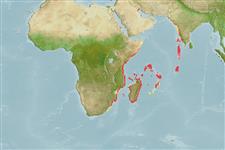>
Acropomatiformes (Oceanic basses) >
Pempheridae (Sweepers)
Etymology: Parapriacanthus: Greek, para = near + Greek, prion = saw + Greek, akantha = thorn (Ref. 45335); punctulatus: Name from Latin 'punctulatus' for dotted; referring to the profusion of dark dots on the side of the body below the lateral line that extend well posterior to the origin of the anal fin; these dots are more evident on preserved specimens than in life..
Environment: milieu / climate zone / depth range / distribution range
ນິເວດວິທະຍາ
ສັດທະເລ ກ່ຽວກັນຫີນ; ລະດັບຄວາມເລິກ 16 - 61 m (Ref. 107896). Tropical
ການແຜ່ກະຈາຍ
ປະເທດ | ເຂດ FAO | ລະບົບນິເວດ | ການປະກົດຕົວ | Point map | ການແນະນຳ | Faunafri
Western Indian Ocean: wide-ranging from South Africa (KwaZulu-Natal) and Mozambique to the Comoro Islands, northern Madagascar, Seychelles, the Mascarene Ridge, and the Mascarene Island of Réunion.
ຂະໜາດ / ນ້ຳໜັກ / Age
Maturity: Lm ? range ? - ? cm
Max length : 6.7 cm SL ຕົວຜູ້/ບໍ່ມີເພດ; (Ref. 107896); 5.0 cm SL (female)
Short description
ສະລີລະວິທະຍາ | ການວັດແທກຮູບຮ່າງລັກສະນະພາຍນອກຂອງດິນ,ສັດ,ປາ…
ຄີ (ໜາມ)ແຂງຢູ່ຫຼັງປາ (ທັງໝົດ): 6; ຄີຫຼັງຂອງປາ (ຄີອ່ອນ) (ທັງໝົດ): 9; ຄີ(ໜາມ) ແຂງຢູ່ຄີກົ້ນປາ
ກຸ່ມປາກະດູກແຂງ
ຄວາມຖີ່ຂອງກຸ່ມຖ່າຍທອດພັນ
ປາທີ່ມີການເຄື່ອນຍ້າຍຈາກທະເລໄປຫານ້ຳຈືດ ແລະນ້ຳຈືດຫາທະເລ
ປາທີ່ມີການເຄື່ອນຍ້າຍຈາກທະເລແລະໄປໄຂ່ຢູ່ນ້ຳຈືດ
ຄີກົ້ນຂອງປາ
ສັດທີ່ມີກະດູກສັນຫັຼງ
ການຖ່າຍທອດທາງກຳມະພັນຈາກພໍ່ແມ່ຫາລູກ 3; ຄີກົ້ນຂອງປາ: 20 - 23. This species is characterized by the following: D VI,9; A III,21 (20-23); pectoral-fin rays 16 (15-17); lateral-line scales 69 (63-72); scale rows above lateral line to base of dorsal fin 5.5; gill rakers 24 (23-26, modally 25); body depth 3.2 (3.25-3.35) in SL, width 2.1 (2.0-2.2) in body depth; depth of caudal-peduncle 10.4 (8.9-9.6) in SL; head length 2.95 (2.8-2.9) in SL; snout length 11.4-13.0 in SL; mouth forming an angle of about 60° to horizontal axis of body; sharply conical, recurved teeth in 2 irregular rows in upper row more forward-projecting, those of second row more strongly recurved; similar smaller teeth in lower jaw, well-spaced, in a single row; very small, incurved, sharply conical teeth in a single irregular row on vomer and palatines; thin lips, covered with closely adjacent papillae; tongue broadly triangular, indented indented on side near tip, forming a small, half-round, flexible flap; predorsal length 2.3 (2.3-2.4) in SL; first dorsal-fin soft ray is longest, 5.3 (4.7-5.4) in SL; caudal fin forked with fin length 4.5 (3.6-4.3) in SL; pectoral-fin length 3.5 (3.25-3.6) in SL; prepelvic length 2.7 (2.5-2.7) in SL; pelvic fins not reaching the anus, fin length 5.9 (5.1-6.5) in SL; preanal length 1.5 (1.5-1.6) in SL; without a pin-like dark line anterior to anus; instead a very dark blue band with a median dull pink streak that narrows anteriorly; black iris in preserved holotype (Ref. 107896).
Stomach contents include a half-digested polychaete about 45 mm by 5 mm, along with copepods, crustacean larvae, and small fishes (Ref. 107896).
Life cycle and mating behavior
ການຈະເລີນເຕັມໄວ | ການສືບພັນ | ການວາງໄຂ່ | ໄຂ່ | ຄວາມດົກຂອງໄຂ່ປາ | ຕົວອ່ອນ
Randall, J.E. and S.V. Bogorodsky, 2016. Preliminary review of the pempherid fish genus Parapriacanthus of the western Indian Ocean, with descriptions of five new species. J. Ocean Sci. Found. 20:1-24. (Ref. 107896)
IUCN Red List Status (Ref. 130435)
Threat to humans
Harmless
Human uses
ຂໍ້ມູນຕື່ມອີກ
ປະເທດເຂດ FAOລະບົບນິເວດການປະກົດຕົວການແນະນຳStocksນິເວດວິທະຍາອາຫານລາຍການອາຫານການບໍລິໂພກອາຫານອັດຕາ
ຊື່ສາມັນຄຳສັບຄ້າຍຄືກັນການເຜົາໃໝ້ພະລັງງານໂດຍປ່ຽນທາດອາຫານໃນຮ່າງກາຍໃຫ້ກາຍເປັນຊີ້ນແລະໜັງຜູ້ລ້າການສຶກສາຜົນກະທົບຂອງສານຜິດທີ່ມີຜົນກະທົບຕໍ່ລະບົບນິເວດການສືບພັນການຈະເລີນເຕັມໄວການວາງໄຂ່ການສັງລວມການວາງໄຂ່ຄວາມດົກຂອງໄຂ່ປາໄຂ່Egg development
Age/Sizeການເຕີບໃຫຍ່Length-weightLength-lengthLength-frequenciesການວັດແທກຮູບຮ່າງລັກສະນະພາຍນອກຂອງດິນ,ສັດ,ປາ…ສະລີລະວິທະຍາຕົວອ່ອນການປ່ຽນແປງຂອງຕົວອ່ອນການທົດແທນທີ່ຄວາມອຸດົມສົມບູນBRUVS
ເອກະສານອ້າງອີງການລ້ຽງສັດນ້ຳຂໍ້ມູນການລ້ຽງສັດນ້ຳສາຍພັນກຳມະພັນElectrophoresesການຖ່າຍທອດທາງກຳມະພັນຈາກພໍ່ແມ່ຫາລູກພະຍາດການປຸງແຕ່ງNutrientsMass conversion
ຜູ້ຮ່ວມມືຮູບStamps, Coins Misc.ສຽງຫອຍມີພິດຊະນິດນຶ່ງທີ່ອາໄສໃນທະເລຄວາມໄວປະເພດການລອຍເນື້ອທີ່ເຫືອກOtolithsສະໝອງວິໄສທັດ
ເຄື່ອງມື
Special reports
Download XML
ແຫຼ່ງອີນເຕີເນັດ
Estimates based on models
Phylogenetic diversity index (Ref.
82804): PD
50 = 0.5005 [Uniqueness, from 0.5 = low to 2.0 = high].
Bayesian length-weight: a=0.01479 (0.00642 - 0.03409), b=3.02 (2.82 - 3.22), in cm total length, based on LWR estimates for this (Sub)family-body shape (Ref.
93245).
ຊັ້ນເຂດຮ້ອນ (Ref.
69278): 3.3 ±0.4 se; based on size and trophs of closest relatives
ຄວາມຢືດຢຸ່ນ (Ref.
120179): ສູງ, ປະຊາກອນຕຳ່ສຸດທີ່ໃຊ້ເວລາສອງໜ້ອຍກວ່າ 15 ເດືອນ (Preliminary K or Fecundity.).
Fishing Vulnerability (Ref.
59153): Low vulnerability (10 of 100).
